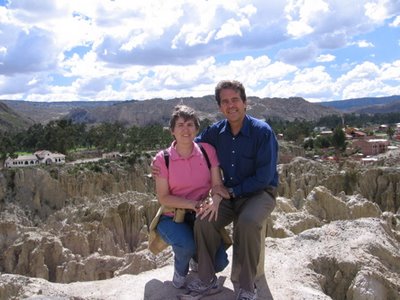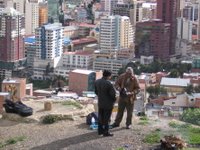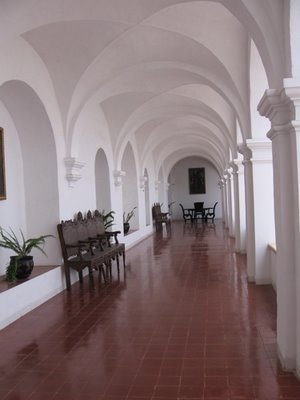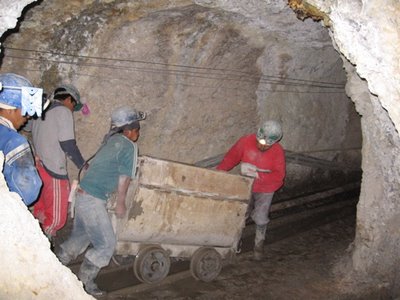
Cindy blew into town Dec. 26 and not a moment too soon. We hadn´t seen each other in three months, the longest separation in our 30-plus years of marriage. This waterspout appeared over Lake Titicaca as we were heading to Copacabana. The crazy weather on this leg of our trip also included a fierce hailstorm that left the ground covered as with snow. The van we were in skidded around on the mountain roads, eliciting yelps from us at moments.


We spent a couple of days in Santa Cruz and then headed for La Paz. We spent an evening there with Luis Ramiro Beltran, who is something of a legend in Bolivian journalism. He was the Defender of the Reader (ombudsman) for eight newspapers here, and he had helped me make connections with the journalists' association in La Paz. He also did a lot of work around the world for Johns Hopkins in the area of health communications, and when he was in Baltimore from time to time, he worked in the Candler Building, the same place I worked. Of course we didn't know each other then.

On our tour of La Paz, Cindy and I took in the Valley of the Moon and went up to a scenic overlook, where we saw an Aymara shaman (he's wearing the hat) working spells for one of his clients. Every so often he and the client would say a few words and toss something into the little fire. Kind of interesting to see this kind of ritual with the metropolitan backdrop. The other scenes are also in La Paz.


Copacabana is a lovely little town on the shore of Lake Titicaca. We spent a night there and headed out to Isla del Sol (the Island of the Sun), where the Incas believed their people, and all of mankind, were born. We stayed in a modest hostel overlooking the lake. It took us a good half hour hauling a ton of luggage up the hill to get to our place. No motor vehicles are allowed on the island, which is deliberately kept primitive. The Aymara Indians run everything. Every square inch of the island was cultivated at one time, to judge by all the terraced seed beds, but many of the fields appear not to be cultivated these days. I had a lot of excellent trout in our three days there.


On our last day we hiked 10 miles round trip to the Inca ritual site. It´s incredibly beautiful and quiet there, high above the lake. The highest point on the island is just over 4,000 meters, or 13,000 feet.
We headed on to Sucre, which is famous for its colonial style architecture. We asked the guide to show us some gardens, and she took us to the cemetery, which is like a little city where the ancestors reside. It was actually very lovely.


These shots are from the church of St. Philip Neri and school.

In Potosi, we went into the legendary Cerro Rico, rich mountain, which produced most of the world´s silver for the past 450 years. They´re still mining silver, zinc, copper and tin out of this same mountain. The mining tunnel we entered runs about a mile into the mountain.

We followed the tracks about 50 meters into the mine and stood inside a little niche where the miners pay tribute to the devil, ruler of the underworld, to ask for his indulgence and protection. The miners give the devil coca leaves, alcohol and cigarettes, which is what they subsist on during their long shifts. Teams of three men push a 1,000-pound handcart into the mine to collect a 2,000-pound load of ore. The guys pushing the empty carts into the mine have to pull their cart off the tracks into a niche and allow the full loads to go by. It´s all by hand. These guys earn about $75 to $150 a month, depending on their status. Lots of miners are in their teens. Our guide, Wilfredo, worked in the mine from the age of 12 till the age of 18. We saw several other young teenagers working there -- 14 and 16.

Wilfredo´s father and grandfather, both miners, died in the same year, his father from silicosis of the lungs at age 37, a common affliction, and his grandfather in a mine collapse.


Cindy looks great, doesn´t she? Although some might think that she may be taking her diet too seriously.

No comments:
Post a Comment